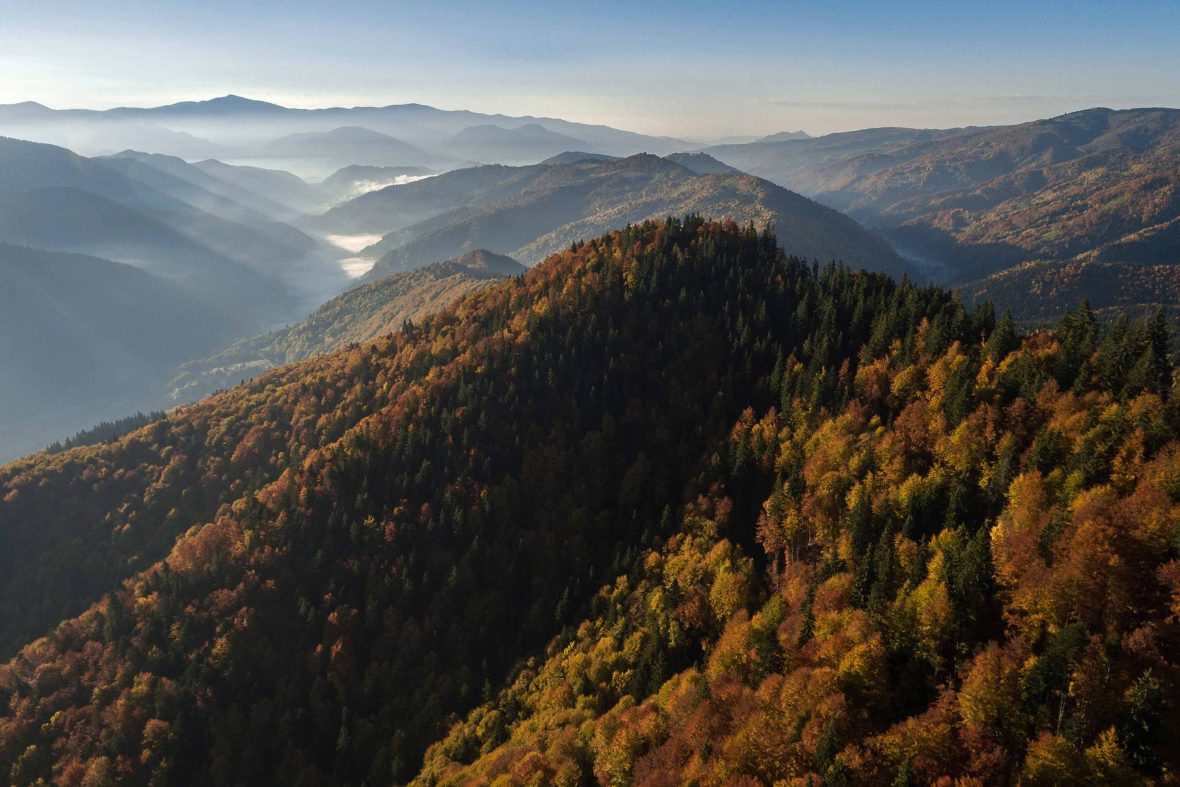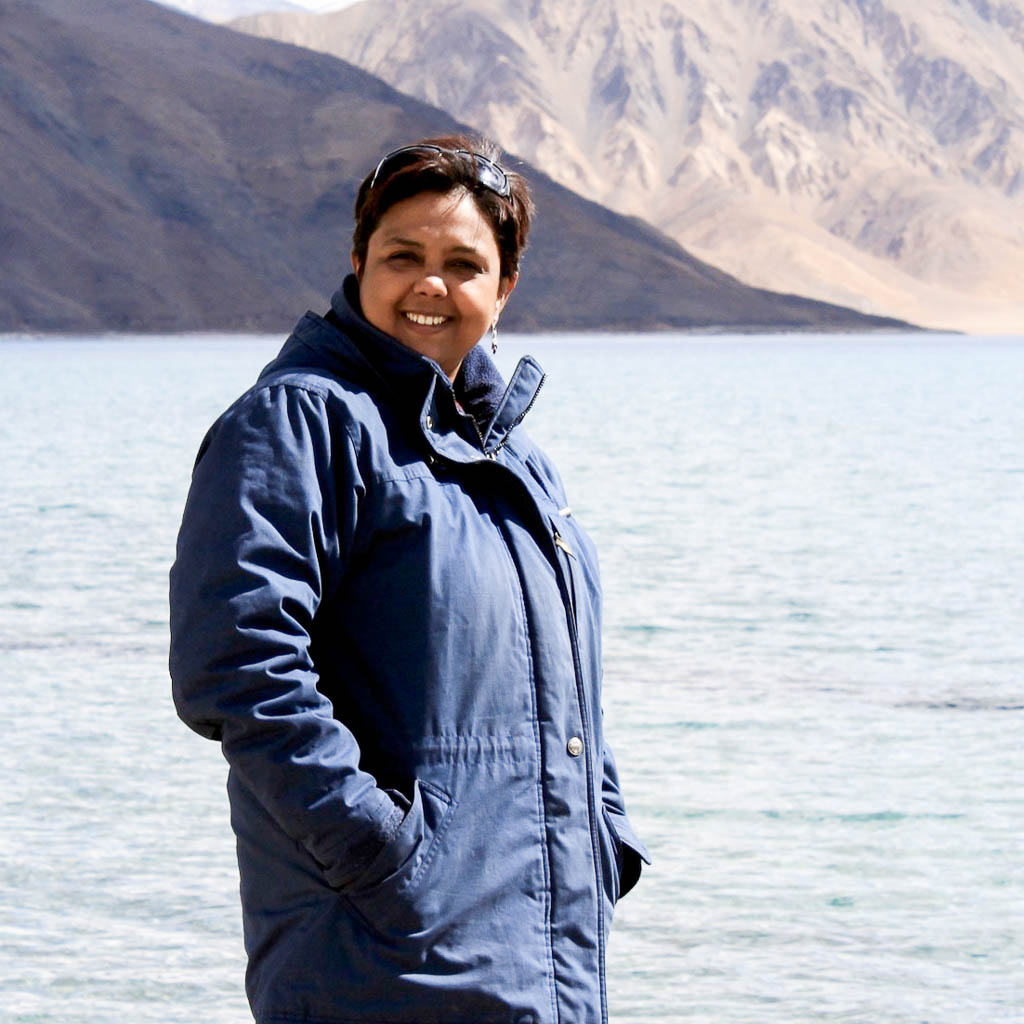
In far south Transylvania, an ambitious rewilding project is already taking root, reviving neglected habitats and re-introducing wildlife, like bison and beavers. Keith Drew finds out what’s next, to ensure the work so far has a lasting legacy.


In far south Transylvania, an ambitious rewilding project is already taking root, reviving neglected habitats and re-introducing wildlife, like bison and beavers. Keith Drew finds out what’s next, to ensure the work so far has a lasting legacy.
“I warned you we’d see lots of poo.”
Bear scat, brazenly piled up in the middle of the track, grabs the attention of my guide Carla Tanasescu, whose voice carries more than a hint of I-told-you-so delight. A bear has passed this way this morning, a wide-set paw print punched into the gritty ground up ahead helping Carla pinpoint its visit.
We are climbing up the wooded slopes of the Dâmbovița Valley, deep within the Făgăraș Mountains in the far south of Transylvania, heading for a wildlife hide that lies somewhere on the ridge above us, still out of view. I’m on an overnight trip with Travel Carpathia, the ecotourism arm of the nonprofit Foundation Conservation Carpathia (FCC), in what is one of Europe’s last great wildernesses.
The vast expanse of old-growth forest here harbors the highest numbers of large carnivores—brown bears, wolves and lynx—on the continent. It also provides a steady supply of timber and a range of game/prey for high-paying hunters. Left unchecked, the forests’ resources could be in danger of being completely consumed. Step forward the FCC, who in 2007 bought its first patch of degraded woodland in what was the start of an ambitious rewilding plan to transform central Romania into the “Yellowstone of Europe”.

Rewilding is, essentially, about turning back the clock. In areas of the world where human intervention has altered the status quo, rewilding resets everything to its original state—and then lets Mother Nature do her thing. It is seen as a big-picture approach to conservation: Whereas traditional methods have tended to focus on the preservation of one particular species, rewilding targets entire ecosystems.
“We talk to the loggers every day, answer their questions, and help them understand what we are doing here and why we are doing it. Their attitudes are slowly changing, but you have to take it one day at a time.”
- Carla Tanasescu, guide
“We are trying to repair the mistakes of the past,” says Angela Boghiu at the FCC’s main office in nearby Brașov. “Communism took the forest from the people but then the government gave it back, and it didn’t matter if that forest was now part of a protected area.” Alongside logging companies, many original landowners, given the sudden opportunity to make money, destroyed huge areas of pristine forest. “It was the Golden Age of illegal clear-cutting,” says Angela.
Clear-cutting is a controversial logging practice where all the trees in an area of forest are chopped down. The FCC started buying clear-cuts in 2012, replanting the old woods with saplings of fir and beech and restoring alpine thickets with rhododendron and juniper, all grown in their tree nursery in the Dâmbovița Valley.
The FCC now has over 25,000 hectares under their protection, but there are pockets of land here that the FCC doesn’t own, and where logging still continues. As Carla drove me along the bumpy forest track that runs into the heart of the valley, we saw freshly sawn tree trunks stacked neatly by the roadside. “We talk to the loggers every day, answer their questions, and help them understand what we are doing here and why we are doing it,” Carla tells me. “Their attitudes are slowly changing, but you have to take it one day at a time.”
The FCC has been making an increasingly important impact on these woods since it was founded in 2009 by Christoph Promberger, a German biologist. Promberger had come to Transylvania some 20 years earlier to study wolves and had already established the Carpathian Large Carnivore Project (CLCP), an enterprise that exposed him to the massive deforestation taking place across the Romanian Carpathians.
Now up to 100 members, the FCC purchases its land using contributions from a range of organizations, including Jack Wolfskin and the European Nature Trust. The main benefactor is the Wyss Foundation, owned by billionaire Swiss conservationist Hansjörg Wyss, whose sister first alerted him to the project after hearing about the idea on one of Promberger’s early wolf-watching trips. Behind this is a board of rewilding heavyweights: The FCC’s directors include Paul Lister—who has enjoyed great success returning the once-depleted forests of Alladale in the Scottish Highlands to their former glory—and Charlie Burrell, owner of the pioneering Knepp Estate in West Sussex, southeast England, where failing farmland has been successfully rewilded and become something of a wildlife haven.
Not all land the FCC buys is clear-cut forest in need of regeneration, though. In the last 20 years, the numbers of bears, wolves and lynx in the Făgăraş have been depleted by poaching and overhunting—it is estimated that since 2016 around 1,400 brown bears, roughly 20 percent of Transylvania’s current population, have been killed by trophy hunters.
The answer? Create your own hunting association, so that you can bid for hunting concessions, but implement wildlife monitoring and anti-poaching programs instead. The FCC now owns 80,000 hectares of land that was destined for trophy hunting but is now a safe haven for wildlife.
Rewilding is the main element to FCC’s ultimate aim: To eventually stitch their patchwork of protected areas together and return it to the Romanian people in the form of a national park that will stretch for 250,000 untamed hectares across the Carpathians.
And not just for bears either. European bison were driven to extinction in Romania, but in 2020, the FCC released the first bison back into the Făgăraș Mountains in over 200 years. The herds are slowly growing—three calves were born in the wild in the summer of 2022 and more adult bison are being released into the environment this year and next.
Beavers are back too. Hunted to extinction, they have already been successfully reintroduced in the northern Făgăraș, and I spot signs along the Dâmbovița River—gnawed tree stumps and a partially built dam—that they are starting to establish colonies on the southern side as well.
Bison and beavers are ‘keystone species’—a term coined by American ecologist James Estes to denote the importance they play in their surrounding ecosystems. Grazing bison naturally increase the biodiversity of their environment. Beavers have been called ecological engineers for the way they reduce flooding and lessen the impact of drought. Their reintroductions should have a huge impact on other species in this area of the Făgăraș Mountains.
Rewilding is the main element to FCC’s ultimate aim: To eventually stitch their patchwork of protected areas together and return it to the Romanian people in the form of a national park that will stretch for 250,000 untamed hectares across the Carpathians. Whether it will achieve this or not relies on the local communities, many of them staunchly traditional, buying into the idea.

“You can’t tell people that they have more to gain from the forest if they leave it as it is; you have to show them,” says Angela. Ecotourism, in the form of hikes and overnighting in rustic wildlife hides like the one I stayed in, is one way to do this, with various locals—drivers, mountain guides, cooks and cabin staff—receiving income directly as a result.
The creation of a food hub, Roadele Munților (‘The Foods of the Mountains’), which promotes local producers, has been another. “We want to protect the natural environment from which we draw our resources and Carpathia (the FCC) encourages mountain communities to do this,” says Bogdan Pîrvu, owner of regional food producer Poiana Fermecată. “This is a business opportunity for us—Carpathia has the power to take this message forward.”
The FCC is also trying to win local support by providing free electric fencing for farmers whose livestock is threatened by bears or wolves and by donating Romanian Carpathian Shepherd puppies to shepherds across the region. “If we could have locked the forest and thrown away the key, it would have been easier,” says Angela. “But it is what you see in the woods and in the communities that makes you want to come back to work every day.”
And it’s what makes you feel that we might just see a European “Yellowstone” after all.
***
The writer traveled with Travel Carpathia, which organizes two- and three-day itineraries in the Făgăraș Mountains including accommodation in wildlife hides in the Dâmboviței Valley, local transport, expert guide and meals.
***
Adventure.com strives to be a low-emissions publication, and we are working to reduce our carbon emissions where possible. Emissions generated by the movements of our staff and contributors are carbon offset through our parent company, Intrepid. You can visit our sustainability page and read our Contributor Impact Guidelines for more information. While we take our commitment to people and planet seriously, we acknowledge that we still have plenty of work to do, and we welcome all feedback and suggestions from our readers. You can contact us anytime at hello@adventure.com. Please allow up to one week for a response.

Keith Drew is a freelance travel writer and editor who writes about unusual places with an interesting story for publications including The Telegraph, BBC Travel and AFAR. He is also the co-founder of family travel website Lijoma.com, a curated selection of inspirational itineraries to more adventurous destinations, such as Iceland, Jordan, Sri Lanka and Japan.








Can't find what you're looking for? Try using these tags: